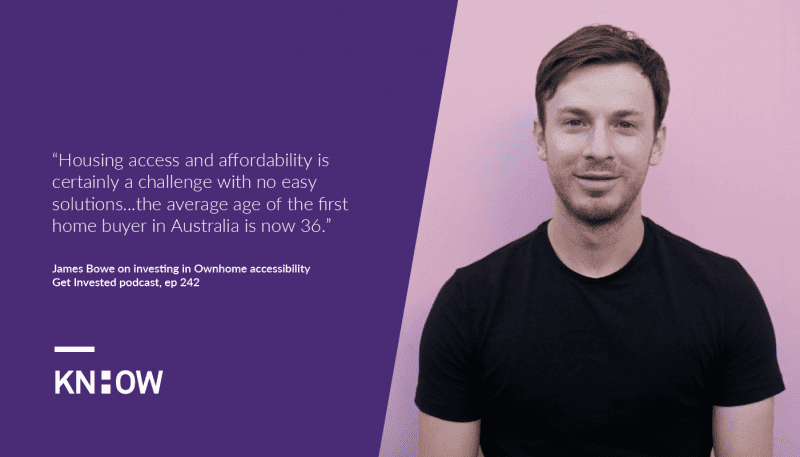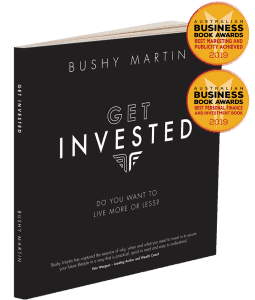Ownhome founder James Bowe talks about Australia’s housing accessibility crisis and how potential home buyers can overcome the challenges of accessing funds.
With house values rising significantly over the last couple of years, many Australians are now struggling to secure the funds to buy their first home.
Fortunately, people like James Bowe, founder of Australian start up Ownhome which helps home buyers and investors with securing a deposit, are working on ways to help people to jump this hurdle.
The house deposit hurdle
On the Get Invested podcast, James and KnowHow founder Bushy Martin shed light on the difficulties Australians face when transitioning from renters to home owners. They said the housing accessibility issue largely stems from an inability to secure the funds for a deposit, even if people are able to make the necessary repayments.
“There’s really a housing access crisis because of the fact that asset price growth has dramatically outstripped wages. And so the average age of the first home buyer in Australia is now 36, so it’s closer to 40 than it is to 20. And the average first home owner is now spending an extra decade in the workforce versus that of our parents’ generation. It’s certainly a challenge with no easy solutions,” James said.
“The major barrier is the deposit hurdle. We lived through a federal election just recently where the cost of living was certainly the focus, but more specifically housing affordability, and then more specifically again it was the deposit hurdle that was front and centre. And there’s no housing crash that’s suddenly going to make this deposit hurdle meaningfully more achievable.
“There’s almost like a meme amongst our generation which is, you know you get rejected from a mortgage that would have cost me $2,000 a month. So don’t mind me, I’ll just go back to paying my $2,500 a month in rent. And so that’s the lived experience of so many aspiring home owners today is they’re so capable of making those monthly payments but are locked out because of that unequal access to that deposit.”
Who is being affected by Australia’s housing accessibility problem?
Home buyers and investors aren’t suffering alone. This issue targets a wide Australian demographic, but particularly those who don’t have financial support or a security blanket provided by family.
“There are 4.5 million young Australians who don’t own the home that they live in. So that’s 18 to 36, I believe, is the age threshold there. There are some folks that are rentvesting, so they own a property but not the home that they live in,” James said.
“If we think about the flow of first home buyers, of which there’s something like 140,000 each year. So now 60% of those rely on the bank of mum and dad for some form of direct financial support, and that is certainly not available to all. But that access to the intergenerational wealth has certainly become an increasingly deciding factor in access to homeownership.”
The flow on social and financial effects
The lack of housing accessibility is seeing major lifestyle changes, especially between home owners versus renters.
“All of the things that cascade from this housing access challenge are really significant and are really changing the way we live. It’s impacting some of the big decisions that people make,” James said.
“So if folks want to have children, that has been overwhelmingly established as being delayed as a direct consequence of how unaffordable people feel housing is. And so they’re delaying having children in order to save up for that deposit.
“The wealth impact is also really significant. Homeowners at retirement are currently 20x wealthier than renters. Of course, there’s some causal correlation challenges in that, but it’s established that housing has been a huge wealth creation engine in Australia, and that is the magnitude of the difference that exists there.
“Another effect is this sense of security. If we look at the numbers here, the average tenure of a homeowner is over ten years, while the average tenure of a renter is around 18 months. And so that gives you some glimpse into the relative uncertainty that’s associated with being a tenant.
“And also, there’s some very obvious and natural consequences that flow from that in terms of people’s ability to have a sense of community. Or even the certainty of, is my child is going to be in the school catchment area, or am I actually going to have to move in 18 months?”
How to seek help
By acquiring the help of businesses like Ownhome, potential home buyers can still achieve their goals of buying their dream home.
“Ownhome assists people with actually buying a quality property to live in, not just anything they can get their hands on. Because if it’s not going to make the grade as far as you’re concerned, and therefore you don’t have the confidence that that property is going to perform well long-term, then obviously it won’t do,” James said.
This quality also extends to the location, an area that experts can provide ample data and information on.
“Home buyers are committed to the property in the sense that this is the community they are looking to put down roots and build a life in,” James said.
“We’re looking for strong demand, we’re looking for diversity of industry in employment. We’re looking for strong income demographics so that people can pay good money for property and continue to pay good money for property. And then you overlay that with lifestyle factors, access to amenities, any infrastructure change, and then also overlay that with school catchment zones.”
Professionals can also ensure you avoid risks and unforeseen costs and damages to a property.
“One of the major benefits is the due diligence that we’re doing effectively on behalf of the future homeowner, even if it’s just by getting a non-vendor sponsored building and pest inspection report. That’s majorly protecting their risk at the time when they officially take the case and get the bank to support the ongoing personal ownership,” James said.
Listen to the full interview here.
Want to Know How you can build wealth with the help of leading, qualified experts? Check us out and talk to the team, now.




